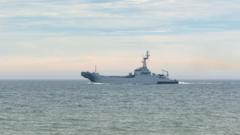Following a series of unexplained damages to undersea cables, NATO's mission comes amid escalating tensions with Russia since the onset of the Ukraine conflict in early 2022. While NATO did not explicitly accuse Russia of these disruptively occurring incidents, Rutte emphasized the importance of monitoring the so-called "shadow fleet"—ships operating under ambiguous ownership that might engage in illicit activities, including transporting embargoed oil. This increased scrutiny is vital as undersea cables are essential for global communications, accounting for more than 95% of internet traffic and significant financial transactions.
Recent events have amplified concerns. There have been several incidents, notably the cutting of an electricity cable between Finland and Estonia, which prompted the Finnish coast guard to intercept a foreign vessel suspected of causing damage. Estonian officials have expressed skepticism regarding the likelihood of such occurrences being accidental. Both Estonia and Sweden's leaders have acknowledged the unsettling frequency of these events and indicated a potential link to hostile activities, despite refraining from direct accusations against Russia.
Rutte stated NATO’s resolve to proactively protect essential infrastructure, affirming that the alliance would respond robustly to potential threats and accidents at sea. The details surrounding the specifics of the Baltic Sentry operation remain undisclosed to avoid giving strategic advantages to any adversaries, reflecting a cautious yet determined approach to safeguarding critical undersea assets in a region marked by increasing geopolitical tensions.
With this latest development, NATO aims to assert its commitment to ensuring the safety and security of the Baltic Sea's undersea communications infrastructure, essential for international relations and economic stability.
Recent events have amplified concerns. There have been several incidents, notably the cutting of an electricity cable between Finland and Estonia, which prompted the Finnish coast guard to intercept a foreign vessel suspected of causing damage. Estonian officials have expressed skepticism regarding the likelihood of such occurrences being accidental. Both Estonia and Sweden's leaders have acknowledged the unsettling frequency of these events and indicated a potential link to hostile activities, despite refraining from direct accusations against Russia.
Rutte stated NATO’s resolve to proactively protect essential infrastructure, affirming that the alliance would respond robustly to potential threats and accidents at sea. The details surrounding the specifics of the Baltic Sentry operation remain undisclosed to avoid giving strategic advantages to any adversaries, reflecting a cautious yet determined approach to safeguarding critical undersea assets in a region marked by increasing geopolitical tensions.
With this latest development, NATO aims to assert its commitment to ensuring the safety and security of the Baltic Sea's undersea communications infrastructure, essential for international relations and economic stability.




















